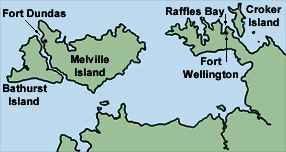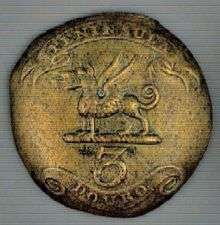Fort Dundas
Fort Dundas was a short-lived British settlement on Melville Island between 1824 and 1828 in what is now the Northern Territory of Australia. It was the first of four British settlement attempts in northern Australia before Goyder's survey and establishment of Palmerston, now known as Darwin. The three later attempts were at Fort Wellington, Port Essington and Escape Cliffs.

Establishment
Captain J. J. Gordon Bremer set sail on HMS Tamar from Port Jackson on the 24 August 1824 to colonise the northern part of Australia. His ship was accompanied by HMS Lady Nelson, and Countess of Harcourt. The ships transported Captain Maurie Barlow, Lieutenant John Septimus Roe, Lieutenant Everard and 23 men of the 3rd Regiment, a subaltern and 26 men of the Royal Marine, a surgeon, three commissariat workers, three free men seeking adventure and 44 convicts.[1]
The construction of a settlement began upon arrival on 27 September 1824.[2] It was officially proclaimed on 21 October 1824, on Trafalgar Day. It was named Fort Dundas and was named after Robert Dundas, the First Lord of the Admiralty.
The intention was to commence and develop trade with the Malays. During the first two years, the settlers never saw a Malay. Furthermore, the settlers had not been able to penetrate more than 20 miles into the island's interior "due to the hostility of the natives – being in the most savage state of barbarism, and all attempts to conciliate them proving abortive"; such was the report to the British people.[3] The establishment of the settlement caused the border of New South Wales to be moved west from the 135th meridian to the Western Australian border (129th meridian).[1]
Captain Bremer was relieved by a Scot, Major John Campbell in 1827. Campbell's party was the first to include women. The first marriage in the Northern Territory occurred shortly after at the fort. In his party was the wife of Lieutenant Hicks, who died shortly after.[1]
Tiwi resistance
The Tiwi put up strong resistance to the new settlers on their land.
There was no contact between the colonisers and the indigenous people of the Tiwi Islands, the Tiwi people, during the first few weeks of the settlement. Bremer noted that the first recorded meetings occurred on 25 October 1824. Exploring a small river on Bathurst Island across the strait from the settlement, Bremer came into contact with a party of ten Tiwi men. Bremer described them as initially defensive and aggressive, calming down upon the presentation of gifts:
After some time they gained confidence and came so near as to take a handkerchief and other trifles we put towards them on an oar... having given them all the boat afforded I left them apparently well satisfied.[1]
On the same day two convicts were seized but not injured. The Tiwi retreated when troops appeared on the scene, taking the convicts’ axes with them. Bremer suspected the Islanders had been watching the settlements for some time and saw the valuable metal and tools.[4]
Attacks on the fort became regular, "sometimes daily". Two people were speared to death including the fort's surgeon, Dr Gold. He was discovered with 31 spear wounds. Seven spear heads remained in his body. One had passed through his head "from ear to ear". The storekeeper John Green had 17 spear wounds and his skull was smashed open.[1]
Abandonment
Bad relations with the Tiwi people, tropical storms, isolation and low food and medical supplies caused Campbell to request that the post be closed and the garrison taken away from "this vile island". He was relieved by Captain Humphrey Hartley, but orders were received shortly after to abandon the fort in late 1828. The last of the settlers left by April 1829. One soldier could not be found and was left behind, with his wife and family sailing without him.[5]
South Australian governor Lord Kintore later declared Bremer's selection of Fort Dundas as ill-suited and "never satisfactorily explained".[1]
Excavations and recent history

Remnants of the fort were visible in 1895, nearly 70 years after the fort's closure. The moat and stonework from a building, thought to be a church, were present as were grave sites.[6] There were several visitors to the site in the early 1900s, who observed the remains of earthworks, part of a stone wharf, a building, and retaining walls, and noted that the once-cleared hillside had regenerated.[7][8]
A commemoration event was held in Darwin in 1924, a century after the abandonment of the fort.[9][10] In 1938 relics of uniforms worn at Fort Dundas were found during a medical survey of Melville Island. They were donated to the Mitchell Library at the University of Sydney in 1972.[11] In 1939, original stones were retrieved from Fort Dundas[12][13] and used to construct a memorial to the early settlement at Darwin's garrison which was unveiled in 1945.[14] Also in 1939, mobile patrol units were established at the fort aimed at preventing trespassing on Aboriginal reserves.[15]
A 49-day excavation was completed in 1975, which mapped and documented the condition of site. Artefacts were found including a glass bottle and a 3rd Regiment brass badge or 'Shako Plate' which are now held at the Museum and Art Gallery of the Northern Territory in Fannie Bay in Darwin. The final report recommended an ongoing research program of the site.[16]
See also
References
- Lockwood, Douglas (1968). The Front Door: Darwin 1869-1969. Adelaide: Rigby Limited. ISBN 978-0727020253.
- "THE NEWLY FORMED BRITISH SETTLEMENT ON THE NORTH WEST COAST OF AUSTRALIA". The Australian (22). New South Wales, Australia. 10 March 1825. p. 3. Retrieved 8 January 2017 – via National Library of Australia.
- "Melville Island". The Asiatic Journal and Monthly Register for British and Foreign India, China and Australasia. Parbury, Allen, & Co. 24. 1827. Retrieved 9 January 2017.
- Morris, John. "The Tiwi and the British: an ill-fated outpost" (PDF). Aboriginal History. 25. ISSN 0314-8769. Retrieved 8 January 2017.
- "Fort Dundas - Melville Island NT". Past Masters. Past Masters. Retrieved 8 January 2017.
- "Fort Dundas—Melville Island". Northern Territory Times And Gazette. XX (1133). Northern Territory, Australia. 19 July 1895. p. 3. Retrieved 8 January 2017 – via National Library of Australia.
- "IN NORTHERN SEAS". The Observer (Adelaide). LXII (3, 305). South Australia. 4 February 1905. p. 4. Retrieved 8 January 2017 – via National Library of Australia.
- "FORT DUNDAS, NORTHERN TERRITORY". The Observer (Adelaide). LXIII (3, 387). South Australia. 1 September 1906. p. 48. Retrieved 8 January 2017 – via National Library of Australia.
- "Centenary Celebrations". Northern Territory Times And Gazette. Northern Territory, Australia. 23 September 1924. p. 2. Retrieved 8 January 2017 – via National Library of Australia.
- "1824—1924: DARWIN (N.T.) CENTENARY CELEBRATION, WITH SOME SIDELIGHTS ON A "WHITE" AUSTRALIA". Western Mail. XXXIX (2, 024). Western Australia. 13 November 1924. p. 19. Retrieved 8 January 2017 – via National Library of Australia.
- "Uniform relics of the 57th Regiment from the site of Fort Dundas, Melville Island, September 1826-1829". State Library of New South Wales. New South Wales Government. Retrieved 7 January 2017.
- "MEMORIAL TO EARLY SETTLEMENTS". Northern Standard (102). Northern Territory, Australia. 30 December 1938. p. 14. Retrieved 8 January 2017 – via National Library of Australia.
- "PIONEER SOLDIERS MEMORIAL". Northern Standard (4). Northern Territory, Australia. 13 January 1939. p. 16. Retrieved 8 January 2017 – via National Library of Australia.
- "PORT ESSINGTON MEMORIAL CAIRN UNVEILED BY GOC AT LARRAKEYAH". Army News. 5 (1351). Northern Territory, Australia. 5 November 1945. p. 4. Retrieved 8 January 2017 – via National Library of Australia.
- "MOBILE PATROL UNITS". Northern Standard (25). Northern Territory, Australia. 28 March 1939. p. 8. Retrieved 8 January 2017 – via National Library of Australia.
- Crosby, Elenor (1975). "Survey and Excavation at Fort Dundas, Melville Island, Northern Territory, 1975". The Australian Society for Historical Archaeology. doi:10.4227/11/504586DEB599D.
